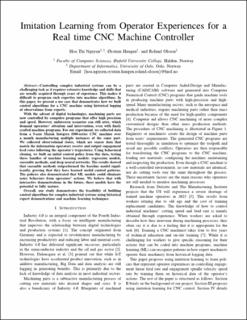| dc.description.abstract | Controlling complex industrial systems can be a challenging task as it requires extensive knowledge and skills that are usually acquired through years of experience. This makes it difficult to program such expertise into machine algorithms. In this paper, we present a use case that demonstrates how we built control algorithms for a CNC machine using historical logging of observations from experts. With the advent of digital technologies, machining parts are now controlled by computer programs that offer high precision and speed. However, unforeseen scenarios can still arise, which demand operators’ attention and intervention, even with finely crafted machine programs. For our experiment, we collected data from a 5-axis Mazak Integrex i500-series CNC machine over a month manufacturing multiple instances of the same part. We collected observational states, which are sensor data that match the information operators receive and output engagement feed rates following the operator’s trajectories. Using behavioral cloning, we built an initial control policy from this data, testing three families of machine learning models: regression models, ensemble methods, and deep neural networks. The results showed that ensemble methods outperformed the baseline model significantly, proving that they have learned useful control patterns. The policies also demonstrated that ML models could eliminate noisy behaviors from operators’ actions. We believe that with interactive demonstrations in the future, these models have the potential to fully mature. Overall, our study demonstrates the feasibility of building control algorithms for complex industrial systems using historical expert demonstrations and machine learning techniques. | en_US |
